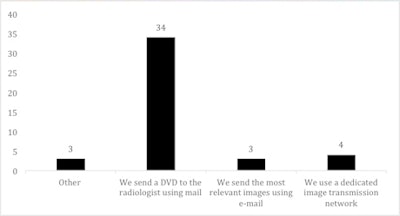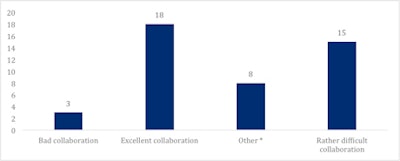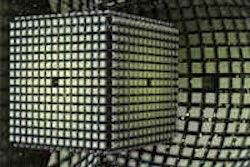
Radiologists want extra training and support on IT-related issues, plus better image distribution between hospitals using a secure digital network and further implementation of service level agreements (SLAs) involving radiology and IT departments, according to the findings of a Dutch survey.
Other top priorities are software developments to enable easy implementation of structured reporting (SR) and the creation of a nationwide teaching database, found the survey conducted in September 2013 by the ICT Committee of the Radiological Society of the Netherlands (NVvR).
"The management of PACS and IT systems in the radiology department doesn't seem to be organized in a seamless manner; usage of SLAs is insufficiently known and should therefore be encouraged," noted the two authors, Dr. Erik Ranschaert of Jeroen Bosch Ziekenhuis and Dr. Alex J.T. Wanders from Voorhout, both of whom are radiologists.
"The involvement of radiologists in the management of these systems is waning," they added. Some respondents even stated that the leading position of radiologists is lost and that the role of radiologists has become rather formal and passive. This is especially true once the PACS is installed; radiologists are insufficiently steering further optimization of the workflow with the system."
Use of SR is currently not well established, mainly due to technical reasons and the lack of commercially available software allowing efficient integration of structured reporting in the daily workflow, they reported in an e-poster presentation at ECR 2014. Integration of coding systems such as RadLex and SNOMED-CT with structured reporting is not yet widely implemented.
Additionally, most of the 53 respondents think the knowledge of radiology-related IT-systems is lagging behind among radiologists and that postgraduate training and more support is necessary from the national radiological society, the authors found.
The questionnaire used the free Web-based Google Docs application and contained 32 questions on seven topics about these subjects: systems (PACS, RIS, electronic patient record [EPR], and postprocessing software); teleradiology and image transmission; PACS- and IT-management in the radiology department; knowledge of informatics and interest of radiologists in IT; usage of structured reporting; and usage of teaching databases.
Agfa Healthcare and Carestream Health PACS were the most common systems. In most hospitals (82%), PACS and RIS were fully integrated, but integration of PACS with the EPR was established in only 25% of hospitals, which in most cases are nonacademic institutions. All participants use speech recognition, the dominant system being G2 Speech using SpeechMagic technology from Nuance (70%).
Most radiologists (84%) could view images at home, an option they use most often in on-call situations where reporting is done the day after (77%). Only three respondents (7%) had a fully integrated workstation at home with reporting facilities. In most cases where a second opinion/expert opinion was required, images were sent by conventional mail using a DVD (77%).
 Image transmission for second opinions: How can radiologists in your hospital obtain a second opinion elsewhere? Source: Dr. E. Ranschaert and Dr. A.J.T. Wanders, presented at ECR 2014.
Image transmission for second opinions: How can radiologists in your hospital obtain a second opinion elsewhere? Source: Dr. E. Ranschaert and Dr. A.J.T. Wanders, presented at ECR 2014.Only 9% of the respondents could use a secure digital network for image distribution between hospitals, the survey found. A total of 93% of the radiology groups expressed the desire to be able to transfer images digitally to other hospitals. For 68% of them, any secured digital network connection complying with Integrating the Health Enterprise (IHE)-standards was the preferred type of connection, while 16% said they preferred a Cross-enterprise Document Sharing (XDS)-type of network, although only 43% of respondents knew what XDS meant.
In only one academic hospital were images being outsourced for primary readings using (extramural) teleradiology. Almost one-quarter of all participants said they were willing to use teleradiology in the future, and 55% said they were not outsourcing and were not considering doing so.
In most hospitals (61%), an agreement existed between the radiology unit (RVE-unit) and the hospital IT department, the former being responsible for the PACS and the latter for the network. In 9% of the hospitals, both PACS and network were managed and controlled by the radiology department, and in 18% the hospital-wide IT department took care of both PACS and network. About 8% of respondents also mentioned an active involvement of the PACS vendor in the management of the system.
Only 45% of the radiologists were aware of the existence of an SLA between the radiology and IT departments, and 54% stated there was no SLA. On collaboration between the IT department and RVE, opinions were equally divided: 41% said it was tedious to downright bad, and 41% indicated they have healthy cooperation. When asked whether radiologists were sufficiently involved in the procurement and management of PACS or other radiology-related IT system, a majority (68%) confirmed this, but 29% of respondents believed radiologists have inadequate involvement.
 How is the collaboration between radiologists and the IT department? Source: Dr. E. Ranschaert and Dr. A.J.T. Wanders, presented at ECR 2014.
How is the collaboration between radiologists and the IT department? Source: Dr. E. Ranschaert and Dr. A.J.T. Wanders, presented at ECR 2014.Slightly more than half of participants (57%) thought radiologists were insufficiently aware of radiology-related IT systems and that they should pay more attention to developments in this field. In addition, 72% believed the NVvR should devote more attention to the subject of radiology-related IT systems and developments. Three-quarters of participants thought the NVvR should create a website and/or forum related to the topic of PACS and IT issues.
Almost all participants (98%) were familiar with the concept of SR, and 11% indicated they already used it. A total of 39% were seriously considering using SR. Standard reports were already being utilized by 50% of the respondents for various types of examinations, mostly for breast imaging (36%). Not one radiology group was using SR with integration of a coding system such as RadLex or SNOMED CT.
Most teaching file systems were created within the existing PACS (43%); only 16% were using a homemade system, and 23% said they did not have any teaching file system. Only three radiology groups (7%) indicated they have purchased a commercially available system. Half of all respondents agreed that a nationwide interactive teaching file system should be created, but 36% did not consider this to be useful.
"From this survey it becomes clear that most Dutch radiology departments are well digitized. In most PACS the RIS is fully integrated, but only in one-quarter (25%) is the PACS linked to the EPR," the authors wrote. "There is a very strong need and demand for a digital image distribution network between Dutch hospitals. Moreover, the DVD-based image exchange system no longer meets the current legal requirements, stipulating that privacy-sensitive data should be transferred using a state-of-the-art method, i.e. digitally and appropriately secured."
Therefore, radiologists are right to insist that digital image exchange is currently insufficient, concluded Ranschaert and Wanders, who have prepared an article in Dutch containing the full details of the survey. It is likely to be posted on the NVvR website.



















